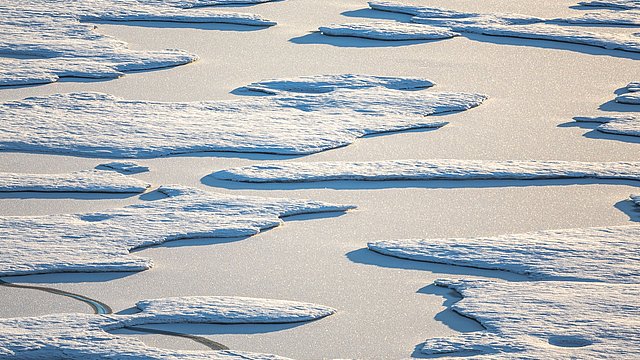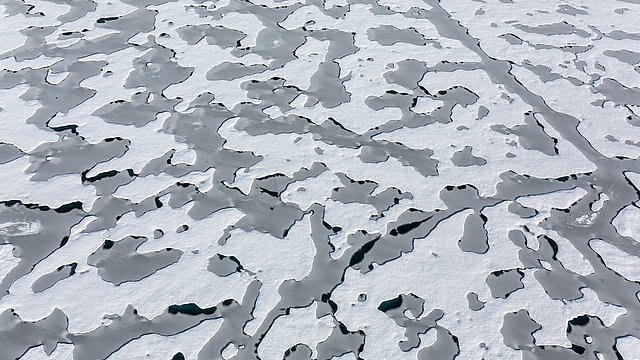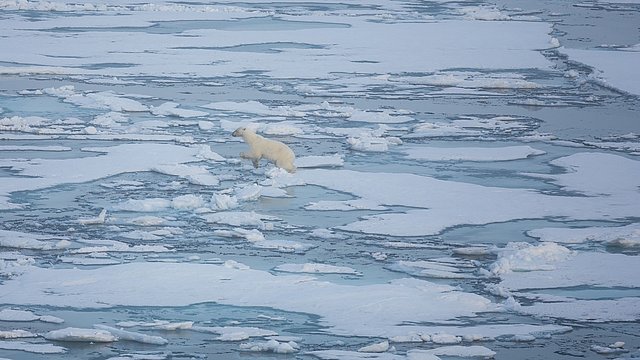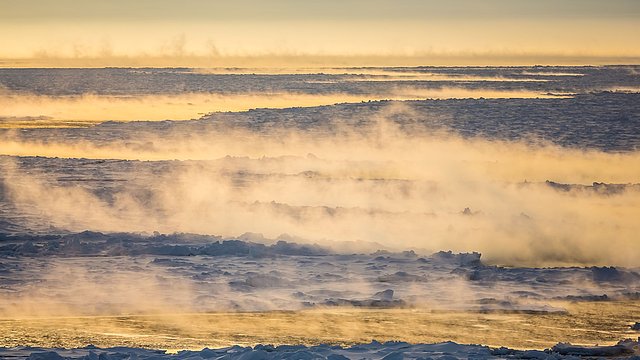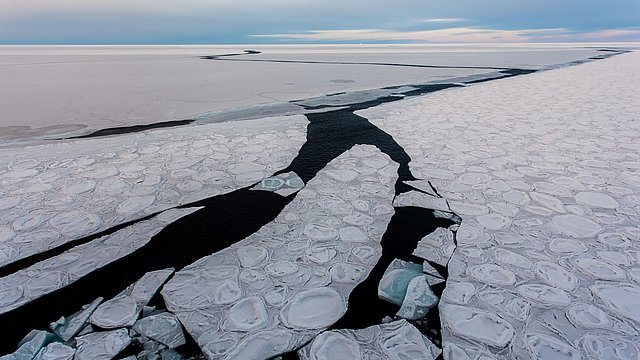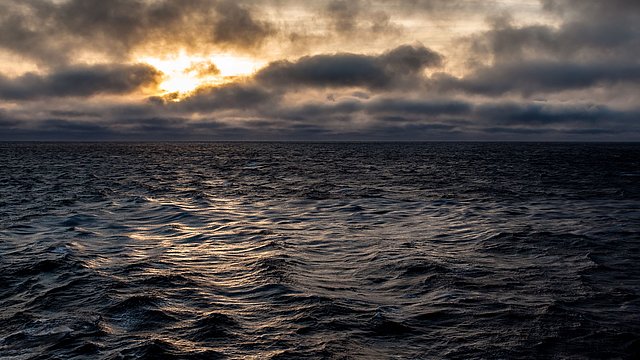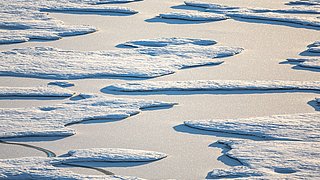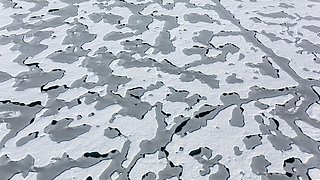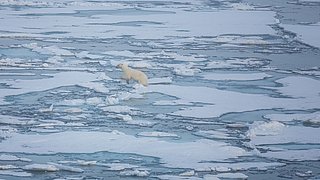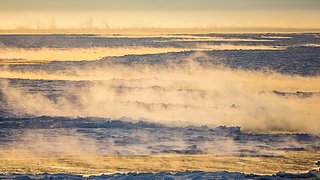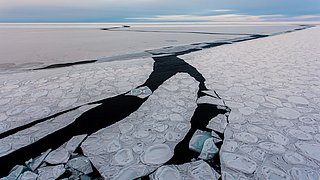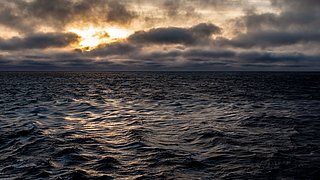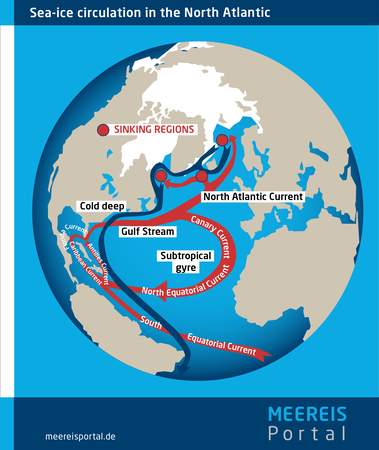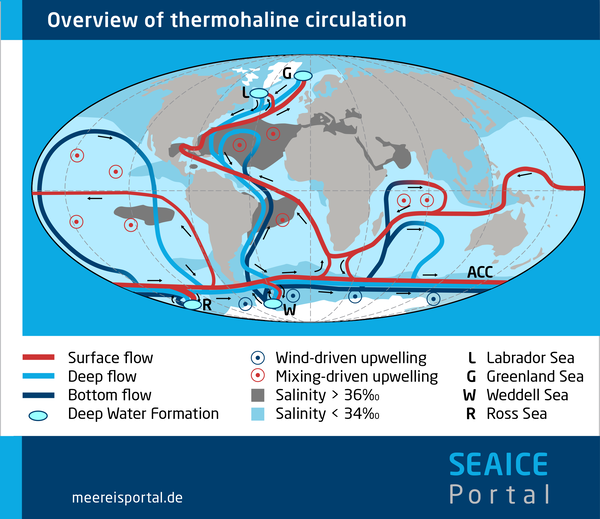Sea Ice and Ocean
Apart from winds, above all density differences in the water are what drive ocean currents and overturning. Seawater becomes denser when its salinity increases and/or its temperature drops.
This motor for ocean currents, powered by density differences, is referred to as “thermohaline circulation”. Here, “thermos” stands for temperature changes and “halin” (from the Greek word for salt) stands for changes in the salinity.
In higher latitudes, the winter sea-ice formation produces large quantities of heavy water. The brine contained in sea ice is substantially more saline and therefore denser than seawater (see Sea-ice Desalination). Consequently, over time this brine seeps out of the sea ice, finding its way into the ocean below. The amount of salt in the ice steadily declines, while rising in the underlying ocean. Due to the increased salinity and low water temperatures, the surface water’s density increases, causing the water to sink.
In this way, e.g. to the east of Greenland in the Arctic and in the Weddell Sea in the Antarctic, large quantities of oceanic deep water are formed. These sinking polar water masses create an incredibly powerful suction effect on the surface, causing warm surface water from the lower latitudes to flow poleward. Conversely, in the ocean’s depths, massive quantities of water flow toward the Equator. As such, deep-water formation in the polar regions is a central component and main driver of global ocean circulation – also known as thermohaline circulation or the “global conveyor belt”. This conveyor belt is vital to the Earth’s climate. It not only distributes heat around the planet, but also transports roughly a third of anthropogenic carbon dioxide emissions from the ocean’s surface to the deep sea, where it can remain for centuries before finally coming into contact with the atmosphere again. Without thermohaline circulation, Earth would already be a much warmer place.
Given the essential role of sea ice in deep-water formation, a further loss of ice due to climate change would have significant consequences for the global ocean circulation and the climate: without sea-ice formation, the salinity of surface water in the polar regions wouldn’t increase, causing deep-water formation, and with it, the entire conveyor belt to falter.
Perhaps the best-known part of the global conveyor belt is the North Atlantic Current, more commonly referred to as the Gulf Stream. This term is often – and incorrectly – used to refer to the entire, complex system of ocean currents reaching from the Caribbean to the waters of the Arctic. However, the Gulf Stream is “only” the first large segment in the system. But regardless of the terminology, one thing is clear: the Gulf Stream and the segments that follow it are like a giant “heater”, which is why Western Europe enjoys an exceptionally mild climate compared to other regions at the same latitude.
Tropical trade winds from the east, the same ones that Columbus used to reach the New World, drive Atlantic surface water from the Caribbean toward the coasts of Central America. Here, the only way for the water to go is through the strait between Cuba and the Yucatan Peninsula in the Gulf of Mexico. Once it’s made its way there, the water flows in a long loop, absorbing substantial heat from the atmosphere in the process. Between Cuba and Florida, it is pushed from the Gulf back out into the Atlantic, where it joins with the Antilles Current north of the Bahamas. Only at this point is the current actually the Gulf Stream.
Now “officially” the Gulf Stream, the ocean current flows up the eastern coastline of the United States to roughly the latitude of North Carolina. At Cape Hatteras, it turns east and flows into the open Atlantic as a focused jet stream roughly 50 km wide and traveling at ca. 5 km/h. There are two reasons for this “right turn” toward Europe: first of all, in this area the winds blow from the west and not from the east (as they do in the Caribbean waters where the Gulf Stream forms), driving water from the New World in the direction of Europe. Secondly, over such a long distance the Earth’s rotation produces a distinctive deflection to the right (Coriolis force).
It is here in the North Atlantic, off the coast of Newfoundland, that the Gulf Stream, powered by winds and the Earth’s rotation, comes to an end, at least technically. When it collides with the cold Labrador Current from the Arctic Ocean, the two currents partially mix, often producing surface fog. This misty union forms the North Atlantic Current, which still contains tremendous amounts of thermal energy from Mexico. The current flows farther across the Atlantic Ocean and toward the British Isles before splitting off the coast of Iceland, with one part flowing west toward Greenland and the other northeast into the European Arctic Ocean toward Norway.
In the process, the gigantic hot water heater unleashes its full effect on Europe. The ocean releases the heat transported by the Gulf Stream into the atmosphere and westerlies blow the mild air onto land. The result: palm trees in Cornwall and fjords that remain ice-free year-round in Norway. While herds of caribou make their way through tundra forests in Canada’s Labrador, farther to the east at the same latitude – in England and northern Germany – lush meadows and deciduous forests thrive.
Estimates vary as to how much thermal energy is actually pumped to the north in this way. But Europe’s heater most likely has a total output of well over 1 billion megawatts, which equates to the nominal output of a million nuclear power plants.
One particularly relevant topic in climate research is the question of how this northward transport of heat and water will be affected by climate change. In this regard, the key to predicting the heat pump’s fate is deep-water formation in the Arctic, which, thanks to its suction effect on near-surface water, represents the main driver of the North Atlantic Current and its extensions. How much heavy water sinks in the Arctic and flows toward the Equator as deep water depends on a number of factors. On its way north, the water of the North Atlantic Current cools substantially, as it releases the heat that it absorbed in Central America into the atmosphere. It also becomes more saline, as the prolonged contact with the atmosphere causes much of the water to evaporate. And it becomes even more saline when, having reached the far north, sea ice forms on its surface. All of these factors increase the water’s density and therefore its weight.
Today, climate change is counteracting this density increase in a number of ways. For one thing, by warming the atmosphere – particularly the air over the Arctic – so that the Gulf Stream and North Atlantic Current release less heat on their journey northward. For another, for many years now researchers have observed a “freshening” of the Arctic Ocean. There are three main reasons:
- As a result of climate change, it more frequently snows and rains in Siberia. As a result, its numerous rivers now transport more freshwater into the Arctic Ocean.
- Due to melting glaciers on the coast, for years the gigantic ice sheet on Greenland has steadily lost mass. For example, in the record-breaking year 2019 it experienced a net loss of 532 billion metric tons. This enormous annual amount of meltwater alone not only made the Arctic Ocean “fresher” but also raised the global sea level by 1.5 millimetres.
- When sea ice is formed, the seawater below the new ice becomes more saline. With the decline in sea ice, this effect is also reduced.
All this – less cooling of the water on its way north, a more moderate salinity increase due to reduced sea-ice formation, and more freshwater input from rivers and melting glaciers – also means the surface water gains less weight, which reduces sinking. Consequently, in the long run this could lead the motor of the Gulf Stream system to falter. The first signs of reduced performance from Europe’s heating system can already be seen today. If we took a look at a world map with the current global warming trends, amid all the red spots in the Northern Hemisphere we would notice a blue spot in the North Atlantic off the coast of Greenland. Bucking the global trend, this region, dubbed the “cold blob” by the scientific community, hasn’t grown warmer at all; in fact, it’s cooled.
A study released by the Potsdam Institute for Climate Impact Research (PIK) in 2018 estimates the drop in pump performance from the mid 20th century to the present at 15 percent. If this trend continues, more of the Gulf Stream’s heat will remain in North America, warming the eastern coast of the USA. In addition, the slowed Gulf Stream, which is currently pulled toward Europe near North Carolina by the Earth’s rotation, will likely come closer to the New England coastline. Given that warm Gulf Stream water is characterised by a higher volume than cold water, sea-level rise could be far more pronounced in New York or Boston than previously assumed.
And what about Europe? Should we expect to see a regional ice age in the near future? Hardly. The slowdown of the heat pump will – assuming this trend continues – happen gradually, in the course of decades or even centuries. In the majority view of the scientific community, the accompanying cooling effect will be more than offset by progressive global warming. Accordingly, in the long term we’ll probably at most see a somewhat delayed rise in temperatures in Europe, but no cooling below today’s temperatures.
In the short term, the faltering heat pump could actually make things hotter and stormier in Europe. After all, the cold blob has an impact on Europe’s weather. For example, in 2015 the North Atlantic was especially cold, which was conducive to the formation of an atmospheric pressure pattern that transported large quantities of hot air from the south to Western Europe in the summer, producing a heat wave. Moreover, many studies predict increased storm activity in Europe, which is connected in part to the weakening Gulf Stream system.
The Southern Ocean surrounding the Antarctic is of key importance in Earth’s climate system. It is here that, on a significantly larger scale than in the North Atlantic, heavy water – and with it, atmospheric heat and dissolved CO2 – is transported into the depths of the world’s oceans. Long-term observations show that, in the past few decades, the ocean south of the 40 S parallel has absorbed more heat than all other waters combined. In the process, the Southern Ocean has buffered much of the atmospheric warming resulting from human greenhouse-gas emissions. What the long-term effects of this additional heat in the ocean’s depths will be is currently the subject of intensive research efforts.
Though the structure of the ocean-current system in the Southern Ocean is highly complex, it can be described in a simplified way using two main transport and overturning currents. The system is dominated by the massive Antarctic Circumpolar Current (ACC), which – driven by powerful westerly winds – moves tremendous quantities of water in a continuous ring around Antarctica. Like a giant turntable, it connects the Atlantic, Pacific and Indian Oceans, controlling the exchange of water masses between the world’s oceans in the process. The transport from west to east is overlaid by a north-to-south (meridional) overturning current, which is powered by a divergence in the larger wind field – i.e., by diverging air masses. At the site of this phenomenon, known as the Antarctic Divergence, upwelling of deep water to the surface occurs, creating powerful suction and, in turn, “dragging” deep water from e.g. the North Atlantic southward. Here we can see the connection to deep-water formation in the Arctic.
After having risen to the surface, the water is transported further on one of two paths. Part of it flows back northward, sinks to a depth of ca. 1,000 metres and flows toward the temperate northern latitudes; it is referred to as Antarctic Intermediate Water (AIW). The other part is transported south into the Antarctic shelf seas, where it makes a substantial contribution to the formation of new deep water. The combination of heat loss to the atmosphere, interactions with the adjacent ice shelf, and salt input via brine from forming sea ice produces water masses with extremely high densities that slide down the continental slope and into the deep sea.
Following deep passages in the mid-ocean range, these water masses move below the ACC and flow into the Pacific, Atlantic and Indian Oceans. Subsequently, they very slowly spread throughout the deep layers of the world’s oceans and only make their way back to the surface in remote upwelling areas, completing the circle of the global ocean conveyor belt, which has a period of ca. 1,000 years. Accordingly, atmospheric heat and CO2 transported to the deep sea by water masses don’t stay there forever; at some point, they literally resurface. If 1,000 years from now humanity has found a way to meaningfully reduce the temperature and atmospheric CO2 from today’s levels, the oceans will go from being a heat and CO2 sink to a heat and CO2 source. They will release their 1,000-year-old cargo into the air again, as a new physical and chemical equilibrium will have formed between the water and atmosphere. And this is just one example of how slowly the climate system reacts; even if greenhouse-gas emissions can be greatly reduced in just a few years, today’s emissions will still have an effect thousands of years from now.
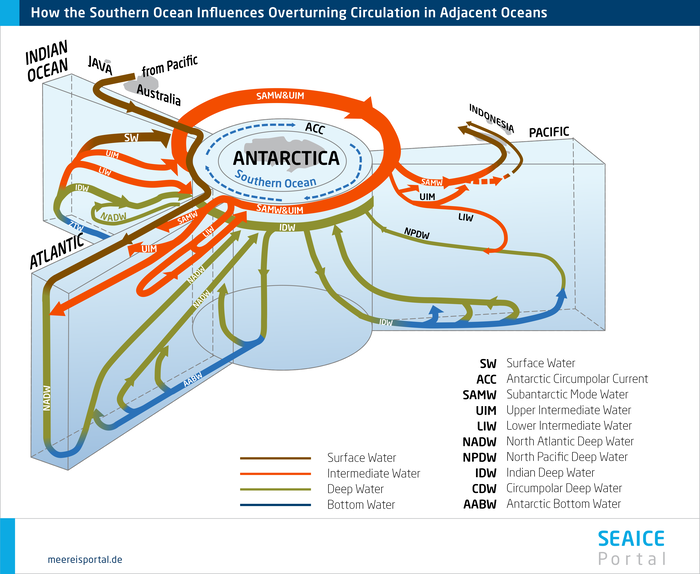
Lumpkin R. & Speer K. (2007): Notes and Correspondence, Global Ocean Meridional Overturning; J. Phys. Oceanogr. DOI: 10.1175/JPO3130.1; pp. 2550-2560; https://www.aoml.noaa.gov/phod/docs/LumpkinSpeer07.pdf
